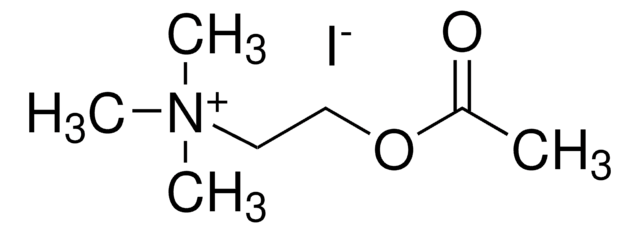A5626
Acetylthiocholine chloride
≥99% (TLC), powder
Synonyme(s) :
(2-Mercaptoethyl)trimethylammonium chloride acetate
Sélectionner une taille de conditionnement
135,00 €
Sélectionner une taille de conditionnement
About This Item
135,00 €
Produits recommandés
Niveau de qualité
Essai
≥99% (TLC)
Forme
powder
Solubilité
water: 100 mg/mL, clear to slightly hazy, colorless
Température de stockage
−20°C
Chaîne SMILES
[Cl-].CC(=O)SCC[N+](C)(C)C
InChI
1S/C7H16NOS.ClH/c1-7(9)10-6-5-8(2,3)4;/h5-6H2,1-4H3;1H/q+1;/p-1
Clé InChI
GZYVLKKMMDFCKR-UHFFFAOYSA-M
Informations sur le gène
human ... ACHE(43)
Application
Actions biochimiques/physiologiques
Mention d'avertissement
Danger
Mentions de danger
Conseils de prudence
Classification des risques
Eye Dam. 1
Code de la classe de stockage
11 - Combustible Solids
Classe de danger pour l'eau (WGK)
WGK 3
Point d'éclair (°F)
Not applicable
Point d'éclair (°C)
Not applicable
Faites votre choix parmi les versions les plus récentes :
Déjà en possession de ce produit ?
Retrouvez la documentation relative aux produits que vous avez récemment achetés dans la Bibliothèque de documents.
Les clients ont également consulté
Active Filters
Notre équipe de scientifiques dispose d'une expérience dans tous les secteurs de la recherche, notamment en sciences de la vie, science des matériaux, synthèse chimique, chromatographie, analyse et dans de nombreux autres domaines..
Contacter notre Service technique










